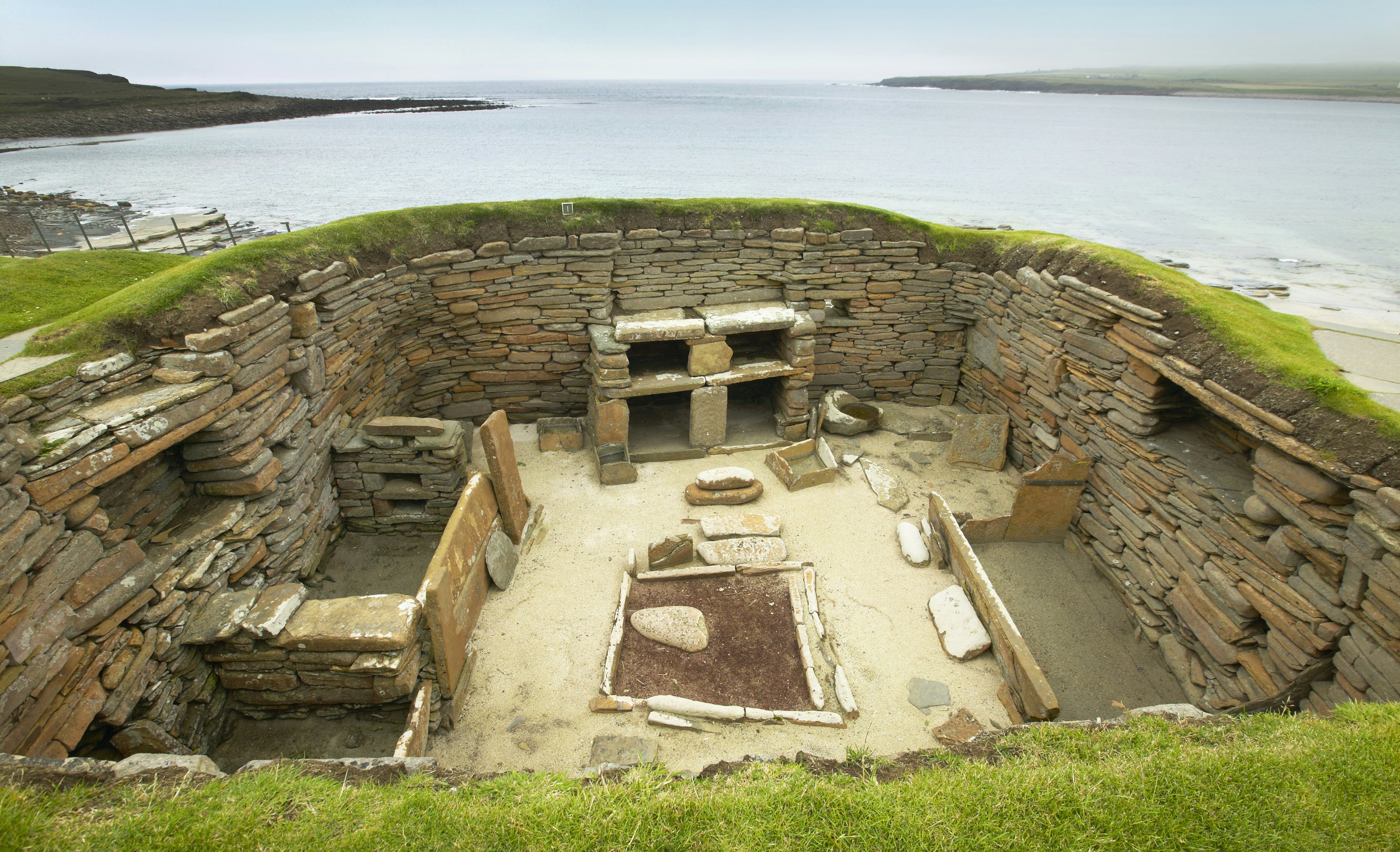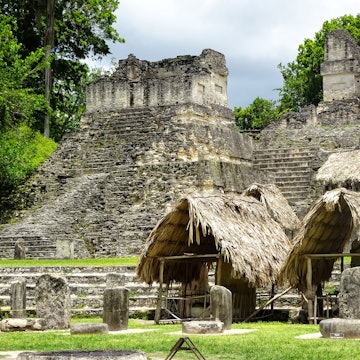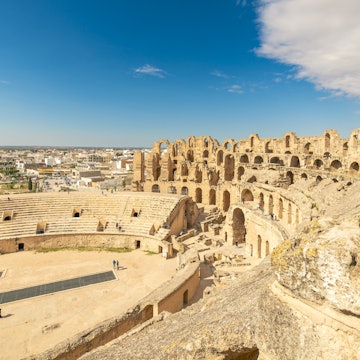

Temple of the Inscriptions and the Palace of the Observatory Tower in the ancient city of Palenque © Soft_Light / Getty Images
War, weather, cosmic intervention, or simply a case of purpose served… nothing lasts forever. Here are some of the world's most intriguing lost cities, towns and settlements.
1. Palenque, Mexico
At the foot of the Chiapas mountains in southwestern Mexico, Palenque is an archaeologist's treasure trove. The city appears to have existed at least since 100 years BCE. Five hundred years later it became a major population center of Classic Mayan civilization, complete with myth and legend: child kings, invasions, decapitations, court intrigue, and finally the abandonment of the city. Palenque has a jungle climate, so prepare accordingly – take sunscreen, insect repellent and plenty of water.
2. Babylon, Iraq
Babylon, in modern day Iraq, was settled around 2500 BCE. It became a great center of the Mesopotamian world 500 years later, when Hammurabi, the first king of the Babylonian empire, made it the capital. It was destroyed in the 6th century BCE by the Assyrians, and then left to fall into ruin in the 2nd century BC, following the death of Alexander the Great. The ruins of Babylon conjure images of a biblical past, including the great Tower of Babel and the beautiful hanging gardens. There's also a certain disco song that just won't leave your head… The city is about 53 miles (85km) south of Baghdad.

3. Angkor, Cambodia
Crumbling stone temples in the python grip of jungle vines, a flash of turmeric-colored robes disappearing into the alcoves of ancient temples. Angkor in Cambodia has its fair share of tourists, but its size means you'll easily find a place to get lost in the distant past. The greater city was enormous, new research suggesting it covered over 1100 sq miles (3000 sq km). Built by a succession of Khmer god-kings from AD 900 to 1200, it had a population close to one million, and was the capital of the Khmer empire. It's been suggested that climate change (affecting water supply) caused the city to be abandoned some 500 years ago. Angkor is 20 minutes north of Siem Reap. Guided and self-guided tours can easily be arranged locally.
4. Dunwich, England
Dunwich, in what is now Suffolk, was a town basking in glory, a major seaport and one of the largest cities in medieval Britain, said to have been the capital of East Anglia – but all built on sand. In the late 13th century a storm blew in, demolishing a good part of the town. Coastal erosion chipped in and before you could say "cursed city", only a few cottages remained (actually, a few hundred years passed as the town slipped into the ocean). Tales of haunted beaches abound, and at low tide you might well hear the muted tolling of church bells beneath the waves. Dunwich Museum has a scale replica of the city in its heyday – without the coastal erosion.

5. Herculaneum, Italy
Like nearby Pompeii, Herculaneum was lost to a river of Vesuvian lava and ash in AD 79. An upper-class town, home to members of the imperial family, it was uncovered around 300 years ago and remains a treasure trove for archaeologists. The pyroclastic flow that enveloped the city carbonized organic matter, preserving structures and human bodies. Most enticing, though, are the hundreds of scrolls found in the Villa dei Papiri, texts from the only ancient library to have survived into modern times. The city can be reached on a 25-minute Circumvesuviana train from Naples. Allow a day to tour the site.
6. Darwin, California, USA
Darwin, like many thousands of towns in late-19th-century USA, sprung up on the back of a lucky strike, in this case, of silver. But these are flash-in-the-pan places – the town became derelict just four years from its settlement in 1878, as prospectors leaped on to the next lucky strike. It was revived in the early 20th century as copper became a commodity. You might bump into a resident today, though chances are it'll be tumbleweed caught on a desert wind.
The edge of Death Valley seems an appropriate place to visit the remnants of a Wild West ghost town. There's only one lonely road to Darwin, spurring from State Highway 190, 47 miles (75km) southwest of Stovepipe Wells.

7. Skara Brae, Scotland
More a village than a city, this prehistoric set of ruins in Orkney, Scotland, is of a small farming settlement over 5000 years old. It was discovered in 1850 after a wild storm revealed the stone remnants. Excavations (and more storms) showed the village had at least eight stone cottages, complete with beds, hearths and shelves. It seems erosion brought the village closer to the sea, until it was abandoned and left to the enshrouding sands for four millennia. Today, erosion continues to threaten the site, and visits in winter depend on weather conditions. Orkney is connected to the British mainland by ferries and flights, some of which are seasonal.
8. Taxila, Pakistan
Founded by an ancient Indian king sometime around the 7th century BCE, Taxila (or Takshashila) is a tale of three lost cities. The first was built on a hill, later known as Bhir Mound. In an Old Testament–style confusion of begats and political intrigue, the city was lost to a new Taxila, known as Sirkap, built by Greek invaders. It enjoyed a period of significance in the world of philosophy and the arts, which continued under the Kushans, who took over and refounded Taxila as Sirsukh. Eventually, the city was lost to the Huns in the 6th century, who destroyed it and left it in ruins. The site today is about 19 miles (30km) northwest of Islamabad. The Taxila Museum houses all manner of artefacts, which help you get a feel for the complex history of this once-great city.

9. Carthage, Tunisia
It's never enough for a great city to be destroyed only once. After 900 years exerting power in North Africa and southern Europe, Carthage succumbed to the wrath of the Roman Empire (needled for so long by the elephant-led armies of Hannibal). Later rebuilt by the Romans and raised to new glory, it once again found itself at the nexus of conflict and was destroyed by Arab Muslims expanding their own sphere of control. Today, on the outskirts of Tunis, you can visit the crumbling remains of Roman baths, temples and villas being absorbed by the sprawl of the capital city. Transport links to the capital, Tunis, are excellent. Carthage is just 9 miles (15km) north of Tunis; numerous day trips are on offer.
You might also like:
Where to travel based on your Harry Potter character
Angkor Wat: get to know Cambodia's most iconic temple
Pompeii: get to know Italy’s legendary ruined city
Article first published in June 2012, and last updated in November 2020.














